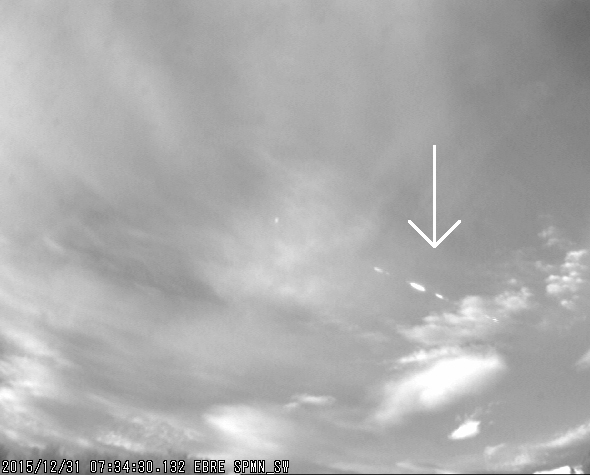In Spain, 2015 Ends With a Cosmic Bang

Photo byEbro Observatory (E. Blanch / CSIC-URLl - JMTrigo / CSIC-IEEC).
On the final day of 2015, a skycam in northeast Spain caught a tremendous fireball—a very bright meteor—burning up in the morning sky:
Photo by Ebro Observatory (E. Blanch/CSIC-URLl - JMTrigo/CSIC-IEEC). That’s a big (9 Mb) animated GIF, so it may take a second to load.
Wow. The camera is operated by the Ebro Observatory. The fireball is pretty stunning; it lasted only a few seconds, but probably got brighter than the full Moon. It was apparently seen by many observers in central and northern Spain.
There are two things I want to point out in the video. It looks like it passes under the clouds, but that’s an illusion. A meteor happens when a solid bit of ice, rock, or metal (called the meteoroid) slams into Earth’s atmosphere from space, moving many dozens of kilometers per second. The huge pressure generated as it compresses the air in front of it heats the gas up, which then glows. This luminous phenomenon is what we call the actual meteor. That typically happens 90–100 kilometers above the ground (though sometimes lower depending on the given event), far higher than the clouds. It’s so bright it shines right through the clouds, though, making it look like it’s just above the ground.
I also suspect that our eyes and brain follow the path the meteor takes, connecting the light in a line. Even if the cloud blocked the light a bit we’d think we saw it as connected.
Also, you can see at least three or four separate flashes of light, a couple of which leave a glow behind (called a persistent train). These happen as the meteoroid breaks up due to the obscene stresses it’s under. As it does so, more meteoroids are created, more surface area is exposed, and the energy released increases momentarily. This is common in very bright meteors. The Chelyabinsk asteroid underwent several disruptive events, flashing madly as it fell apart.
In the case of Chelyabinsk the meteoroid was 19 meters across and outshone the Sun; this event was from a rock much smaller. I hesitate to guess, but it was probably about a meter or so, maybe smaller. Again, I’m guessing here, so don’t take this as gospel!
It’s possible that some small pieces made it to the ground, creating meteorites. If you saw this fireball, I urge you to report it to the Spanish Fireball Network; the more reports they have, the better the trajectory for the fireball they can estimate. That makes finding any meteorites easier.
Meteors this bright occur fairly often, once a month or so. If you see one and live in the U.S., you can report it to the American Meteor Society. Whenever anyone asks me about some bright meteor they saw, that’s the first place I go. And if you get pictures or video, let me know! I love looking at them, and I might run them here on the blog. Thanks. And keep looking up! The sky isn’t exactly falling, but it’s still pretty dang exciting.
Tip o' the Whipple Shield to Grigorij Richters and Asteroid Day.


